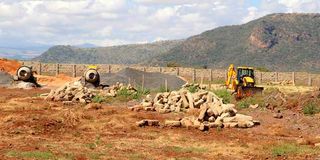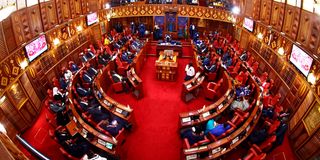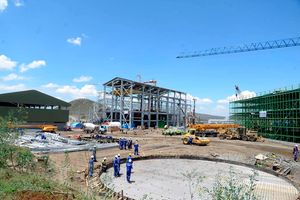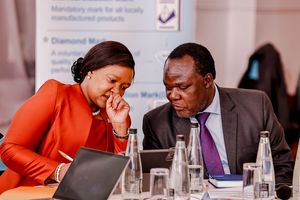
Abandoned equipment at the Meru Aggregation and Industrial Park at Ruiri Rwarera in this photo taken on March 29, 2024.
President William Ruto’s Sh23.5 billion County Aggregation and Industrial Parks (CAIPs) project is at risk of becoming a white elephant, senators have warned, citing poor planning, lack of value for money, and minimal stakeholder engagement.
This follows Auditor-General Nancy Gathungu’s revelation that an audit of the multi-billion-shilling initiative exposed significant gaps in value for money.
Appearing before the Senate County Public Accounts Committee on Monday, Siaya Governor James Orengo said counties were handed the project without consultation. He claimed the national government designed and implemented the scheme unilaterally, leaving counties with warehouses no investors want.
“The national government didn’t assess whether these industrial parks were necessary or how they would serve local needs. Counties were side-lined,” Mr Orengo told the committee, chaired by Homa Bay Senator Moses Kajwang’.

The Senate in a past session.
He said counties, each expected to contribute Sh250 million towards the project, were not only side-lined but also underfunded. Siaya, for instance, has received only Sh53 million from the national government, against the promised Sh250 million, despite contributing Sh123 million itself.
In the financial year ending June 2024, only Sh1.15 billion was disbursed from a Sh4.5 billion budget. For 2025, Sh1 billion has been released out of the Sh2 billion budget, with subsequent phases facing further cuts.
Governor Orengo argued that while the idea may have been worthwhile, it was poorly executed. The one-size-fits-all model ignored local agricultural strengths and investor needs. “A proper design tailored to each county’s needs should have been the minimum. For instance, in Siaya, we need a cotton and textile ginnery – not just a generic warehouse,” he said.
Senator Kajwang’ questioned whether the Sh23.5 billion project was becoming yet another failed conditional grant. “You’re suggesting this is turning into a white elephant?” he asked.
“I think we are heading in that direction,” Mr Orengo responded. “We’ve spent Sh500 million, but with Sh300 million I could have built a functional cotton ginnery.”
He added that potential investors in cotton, leather, and sugarcane industries have all dismissed the warehouses as unsuitable.
Nyamira Senator Okong’o Omogeni asked: “Are you saying this project was forced on Siaya and holds no benefit for your people?”
Governor Orengo replied that national government officials selected the contractors and engineers and executed the works outside of standard county procurement procedures.
Nairobi Senator Edwin Sifuna said the only beneficiaries appear to be those awarded construction contracts. “This was shoved down counties’ throats because someone is making money,” he claimed.
Mr Sifuna also quoted Makueni Governor Mutula Kilonzo Jnr, who allegedly said no one was willing to consult him about the project’s design or size. “This is a scam – like the affordable housing project. The only benefit is to those feeding off it,” Mr Sifuna added.
Taita Taveta Senator Johnes Mwaruma questioned the logic of building parks in counties without any produce to aggregate. “Shouldn’t we ensure agricultural production first?” he asked.
Nandi Senator Samson Cherargei queried whether a legal framework governed engagement between the national and county governments on the project.
In response, Mr Orengo said the national government imposed a standard model across all counties without regard to local needs. “Most parks don’t serve the intended purpose. Many counties would rather spend that money on other priorities,” he said.
When asked if governors had voiced opposition through the Intergovernmental Budget and Economic Council, Mr Orengo said politics made it difficult.
“It was political. If you refused the money while brick and mortar were going up in other counties, you’d be in trouble,” he said.
Makueni governor’s decision to reject the project was cited by Senator Mwaruma: “If Makueni said no, why are other counties taking it up?” he posed.
The committee now wants a comprehensive review of all CAIPs across the 47 counties to assess their viability and alignment with local development priorities.
Lawmakers argue that further expenditure on such projects must be preceded by thorough needs assessments and genuine consultations with county governments and the private sector. They insist that projects of this magnitude should not be driven by political expediency or the interests of contractors.
Civil society groups have called for a moratorium on further disbursements until an audit of all ongoing works is completed.
They warn that the CAIPs risk going the way of other grandiose but failed development projects unless course correction happens quickly.









